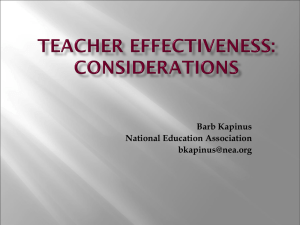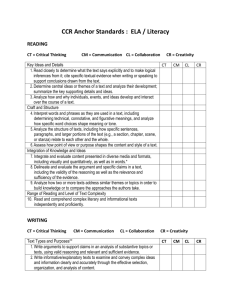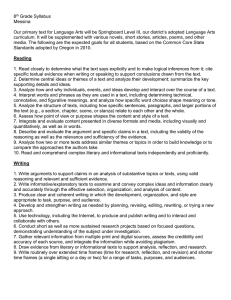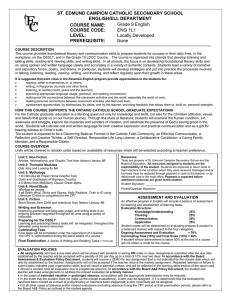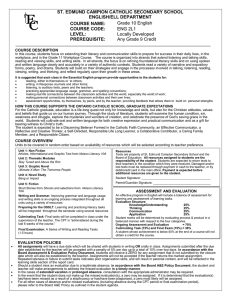INDEPENDENT SCHOOL DISTRICT 196 Rosemount-Apple Valley-Eagan Public Schools 613
advertisement
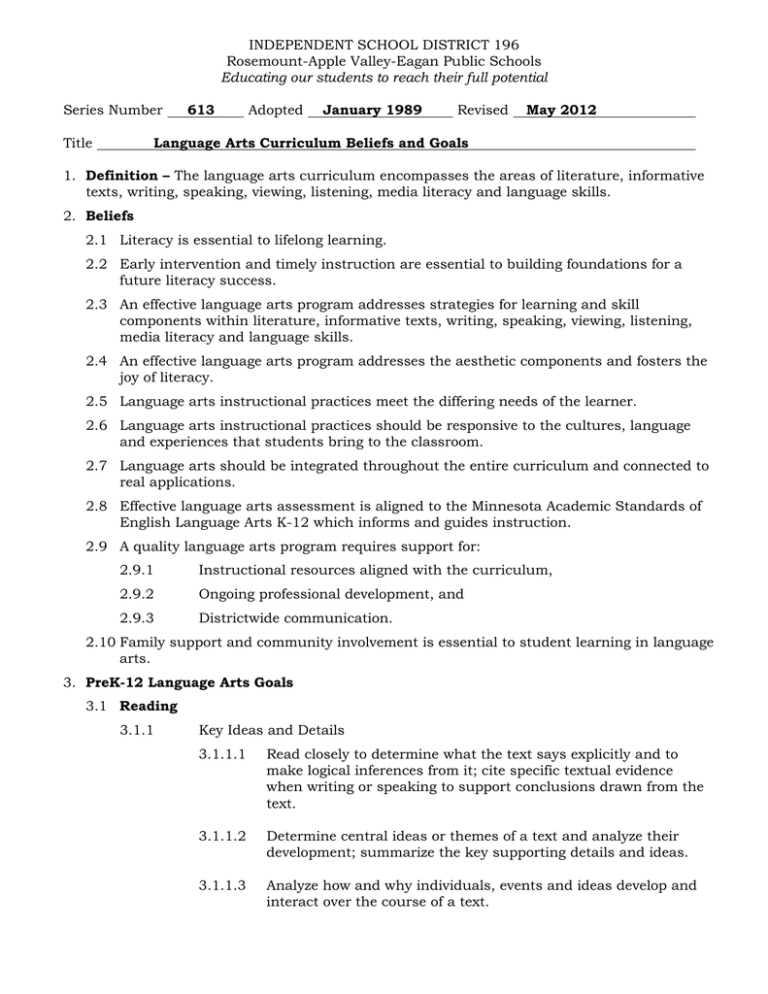
INDEPENDENT SCHOOL DISTRICT 196 Rosemount-Apple Valley-Eagan Public Schools Educating our students to reach their full potential Series Number Title 613 Adopted January 1989 Revised May 2012 Language Arts Curriculum Beliefs and Goals 1. Definition – The language arts curriculum encompasses the areas of literature, informative texts, writing, speaking, viewing, listening, media literacy and language skills. 2. Beliefs 2.1 Literacy is essential to lifelong learning. 2.2 Early intervention and timely instruction are essential to building foundations for a future literacy success. 2.3 An effective language arts program addresses strategies for learning and skill components within literature, informative texts, writing, speaking, viewing, listening, media literacy and language skills. 2.4 An effective language arts program addresses the aesthetic components and fosters the joy of literacy. 2.5 Language arts instructional practices meet the differing needs of the learner. 2.6 Language arts instructional practices should be responsive to the cultures, language and experiences that students bring to the classroom. 2.7 Language arts should be integrated throughout the entire curriculum and connected to real applications. 2.8 Effective language arts assessment is aligned to the Minnesota Academic Standards of English Language Arts K-12 which informs and guides instruction. 2.9 A quality language arts program requires support for: 2.9.1 Instructional resources aligned with the curriculum, 2.9.2 Ongoing professional development, and 2.9.3 Districtwide communication. 2.10 Family support and community involvement is essential to student learning in language arts. 3. PreK-12 Language Arts Goals 3.1 Reading 3.1.1 Key Ideas and Details 3.1.1.1 Read closely to determine what the text says explicitly and to make logical inferences from it; cite specific textual evidence when writing or speaking to support conclusions drawn from the text. 3.1.1.2 Determine central ideas or themes of a text and analyze their development; summarize the key supporting details and ideas. 3.1.1.3 Analyze how and why individuals, events and ideas develop and interact over the course of a text. Policy 613 Page 2 3.1.2 3.1.3 3.1.4 Craft and Structure 3.1.2.1 Interpret words and phrases as they are used in a text, including determining technical, connotative and figurative meanings, and analyze how specific word choices shape meaning or tone. 3.1.2.2 Analyze the structure of texts, including how specific sentences, paragraphs and larger portions of the text (e.g., a section, chapter, scene or stanza) relate to each other and the whole. 3.1.2.3 Assess how point of view or purpose shapes the content and style of a text. Integration of Knowledge and Ideas 3.1.3.1 Integrate and evaluate content presented in diverse media and formats, including visually and quantitatively, as well as in works. 3.1.3.2 Delineate and evaluate the argument and specific claims in a text, including the validity of the reasoning as well as the relevance and sufficiency of the evidence. 3.1.3.3 Analyze how two or more texts address similar themes or topics in order to build knowledge or to compare the approaches authors take. Range of Reading and Level of Text Complexity 3.1.4.1 Read and comprehend complex literary and informational texts independently and proficiently. 3.2 Writing 3.2.1 3.2.2 Text Types and Purposes 3.2.1.1 Write arguments to support claims in an analysis of substantive topics or texts, using valid reasoning and relevant and sufficient evidence. 3.2.1.2 Write informative/explanatory texts to examine and convey complex ideas and information clearly and accurately through the effective selection, organization and analysis of content. 3.2.1.3 Write narratives and other creative texts to develop real or imagined experiences or events using effective technique, wellchosen details and well-structured event sequences. Writing Process: Production and Distribution of Writing 3.2.2.1 Produce clear and coherent writing in which the development, organization and style are appropriate to task, purpose and audience. Policy 613 Page 3 3.2.3 3.2.4 3.2.2.2 Use a writing process to develop and strengthen writing as needed by planning, drafting, revising, editing, rewriting or trying a new approach. 3.2.2.3 Use technology, including the Internet, to produce and publish writing and to interact and collaborate with others. Research to Build and Present Knowledge 3.2.3.1 Conduct short as well as more sustained research projects based on focused questions, demonstrating understanding of the subject under investigation. 3.2.3.2 Gather relevant information from multiple print and digital sources, assess the credibility and accuracy of each source, and integrate the information while avoiding plagiarism. 3.2.3.3 Draw evidence from literary or informational texts to support analysis, reflection and research. Range of Writing 3.2.4.1 3.3 Write routinely over extended time frames (time for research, reflection and revision) and shorter time frames (a single sitting or a day or two) for a range of tasks, purposes and audiences. Speaking, Viewing, Listening and Media Literacy 3.3.1 3.3.2 Comprehension and Collaboration 3.3.1.1 Prepare for and participate effectively in a range of conversations and collaborations with diverse partners, building on others’ ideas and expressing their own clearly and persuasively. 3.3.1.2 Integrate and evaluate information presented in diverse media and formats, including visually, quantitatively and orally. 3.3.1.3 Evaluate a speaker’s point of view, reasoning and use of evidence and rhetoric. Presentation of Knowledge and Ideas 3.3.2.1 Present information, findings and supporting evidence such that listeners can follow the line of reasoning and the organization, development and style are appropriate to task, purpose and audience. 3.3.2.2 Make strategic use of digital media and visual displays of data to express information and enhance understanding of presentations. 3.3.2.3 Adapt speech to a variety of contexts and communicative tasks, demonstrating command of formal English when indicated or appropriate. Policy 613 Page 4 3.3.3 Media Literacy 3.3.3.1 Critically analyze information found in electronic, print and mass media and use a variety of these sources. 3.3.3.2 Communicate using traditional or digital multimedia formats and digital writing and publishing for a specific purpose. 3.4 Language 3.4.1 3.4.2 Conventions of Standard English 3.4.1.1 Demonstrate command of the conventions of standard English grammar and usage when writing or speaking. 3.4.1.2 Demonstrate command of the conventions of standard English capitalization, punctuation and spelling when writing. Knowledge of Language 3.4.2.1 3.4.3 References: - Policies/613/5-14-12 Apply knowledge of language to understand how language functions in different contexts, to make effective choices for meaning or style, and to comprehend more fully when reading or listening. Vocabulary Acquisition and Use 3.4.3.1 Determine or clarify the meaning of unknown and multiple meaning words and phrases by using context clues, analyzing meaningful word parts, and consulting general and specialized reference materials, as appropriate. 3.4.3.2 Demonstrate understanding of figurative language, word relationships and nuances in word meanings. 3.4.3.3 Acquire and use accurately a range of general academic and domain-specific words and phrases sufficient for reading, writing, speaking and listening at the college and career readiness level; demonstrate independence in gathering vocabulary knowledge when encountering an unknown term important to comprehension or expression. Minnesota Department of Education, Minnesota Academic Standards, English Language Arts K-12, 2010, based on the Common Core State Standards in English Language Arts and Literacy in History/Social Studies, Science and Technical Subjects

